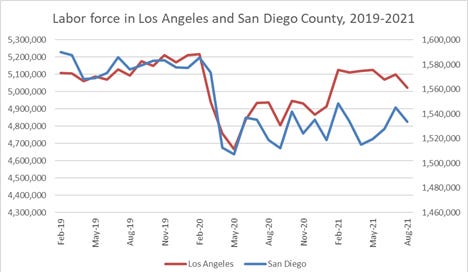Getting back to work: the labor force in Southern California
When economists speak of the “labor force”, they aren’t just referring to people who are currently working. They are also referring to people not currently working but who are actively searching for work – i.e., the unemployed.
If a person doesn’t have a job but is not actively looking for work, the Bureau of Labor Statistics says that they are not officially “unemployed”. Instead, these people are classified as “not in the labor force”. Every economics student learns about this distinction, but it is less well-known among the general public.
The labor force - rather than employment or unemployment directly - can tell its own story about a population’s attachment to the labor market. When the labor force shrinks, it means people are withdrawing from the labor market for some reason – it could be retirement, choosing to stay at home to care for someone, or some other life choice. These people have chosen not to look for work anymore, and whatever the reason, that is big news!
During the pandemic, San Bernardino County’s labor force shrank from 980,000 to 940,000, or about 4%, in roughly 3 months. In other words, by summer 2020, about 4% of the county’s labor force lost itsjob and decided to no longer look for work.
Similar, often deeper, cuts in the labor force were seen throughout Southern California. In LA County over the same 3-month period, the labor force dropped from 5.2 million to 4.7 million, or about 10%. In San Diego County, it fell by about 100,000 workers, or about 5% of the labor force. LA County’s labor force was quicker to recover - see the red line below - but still sits uncomforably below the pre-pandemic level. San Diego county is even worse shape.
The relatively strong shape of labor force participation during the pandemic is one of the reasons San Bernardino County’s labor market is performing better than other parts of Southern California on a range of measures. Our unemployment rate remains high, but our employment and overall participation in the labor market have more quickly returned to pre-pandemic levels.
People are actively searching for work out here, and that makes a difference that might be harder to see in the official unemployment rate statistics. Over the coming months, San Bernardino County should expect to see a change in the composition of its labor force from unemployed to employed, further reducing the unemployment rate.
The problem in other parts of southern California is that people have dropped out of the labor force entirely, and have not returned to search for work. These areas have a larger problem to address. Aside from the life choices mentioned above, there could be a problem with wages simply not being enough to convince people to return to work - whether because of safety or childcare concerns or some other reason. That’s not to say workers out here aren’t going through the same issues, of course.




